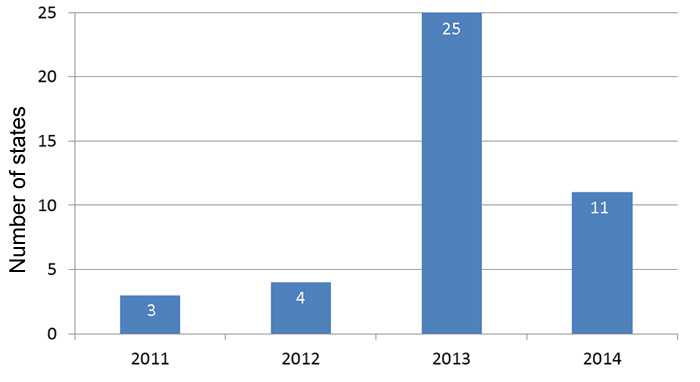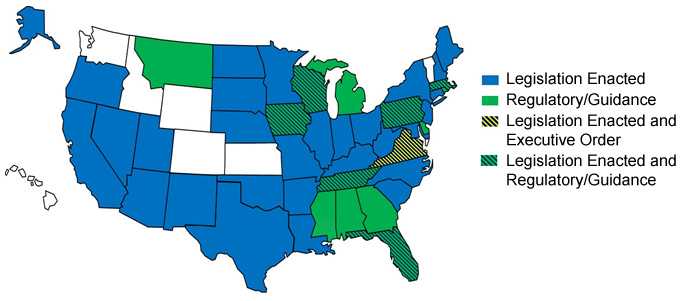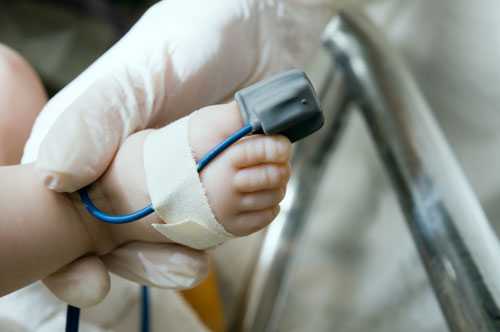Key Findings: State actions to adopt newborn screening for critical congenital heart defects
CDC’s Morbidity and Mortality Weekly Report has published a new study looking at state actions to adopt newborn screening for critical congenital heart defects (critical CHDs) using pulse oximetry – a simple, non-invasive way to measure the amount of oxygen in a newborn’s blood. CDC researchers found that 43 states have taken action toward newborn screening for critical CHDs through legislation, regulations, or hospital guidelines. This report is the first assessment of state actions to adopt newborn screening for critical CHDs and state efforts to collect data about screening. States and hospitals might find this information valuable as they evaluate their efforts and seek to improve their newborn screening programs. You can read the article here.
Main Findings
- Forty-three states have taken action toward newborn screening for critical CHDs through legislation, regulations, or hospital guidelines.
- Of these, 32 states are collecting or planning to collect data about screening.
- The type of data collected varies by state, and may include:
- The total number of babies screened for critical CHDs in the state
- The number of babies that pass or fail the screen
- The oxygen levels of every newborn screened
- The oxygen levels only for those newborns that failed the screen
- A combination of these types of data
Data collection and reporting are essential to evaluate the effectiveness of newborn critical CHD screening.
Basics about Critical Congenital Heart Defects
What are critical congenital heart defects?
Congenital heart defects are the most common type of birth defect in the United States, affecting nearly 1% of―or about 40,000―births per year. About 1 in 4 babies born with a heart defect has a critical congenital heart defect (critical CHD, also known as critical congenital heart disease).1 Babies with a critical CHD need surgery or other procedures within the first year of life.
How can newborn screening help babies with critical CHD?
Some babies born with a critical CHD appear healthy at first and can be sent home before their heart defect is detected. These babies are at risk of having serious complications within the first few days or weeks of life and often require emergency care. Newborn screening can identify some of these babies so they can receive care and treatment that can help prevent disability or early death.
Newborn screening for critical CHD involves a simple bedside test to determine the amount of oxygen in a baby’s blood. Low levels of oxygen in the blood can be a sign of critical CHD. Critical CHD screening has begun in some states, and laws requiring this screening have been proposed or passed in other states. You can see what is happening in your state here.
Number of states first implementing legislation, regulation, or hospital guidelines for newborn screening for critical congenital heart defects by year (N=43) — United States, 2011-2014

State actions since newborn screening for critical CHDs was recommended in 2011*

*State actions as of December 2014
Text version of map
About this study
- In 2011, the Secretary of Health and Human Services recommended that critical CHDs be added to the U.S. Recommended Uniform Screening Panel for newborns.The aim of this study was to assess state activities to establish newborn screening for critical CHDs and state efforts to collect data to evaluate screening.
- Researchers worked with the American Academy of Pediatrics (AAP) Division of State Government Affairs and NewSTEPS, a program of the Association of Public Health Laboratories and the Colorado School of Public Health. NewSTEPS maintains a data repository of state newborn screening program metrics and provides education to programs.
- AAP obtained information about newborn screening in each state from their state chapters.
- NewSTEPS distributed a survey in January 2014 to assess newborn screening for critical CHDs and data collection practices in each state. The survey asked about legislation and data collection requirements at the state level. It also asked about the type of data collected.
CDC’s Activities: Congenital Heart Defects
CDC is working to understand more about the causes and health impact of congenital heart defects with the following activities:
-
Surveillance or disease tracking:
- Infants and children: CDC funds and coordinates the Metropolitan Atlanta Congenital Defects Program (MACDP). CDC also funds 14 population-based state tracking programs. Birth defects tracking systems are vital to help us find out where and when birth defects occur and whom they affect.
- Adolescents and adults: CDC recently started three projects to track congenital heart defects among adolescents and adults in order to learn about their health issues and needs across the lifespan.
- Research: CDC funds the Centers for Birth Defects Research and Prevention, which collaborate on large studies such as the National Birth Defects Prevention Study, or NBDPS (births 1997-2011) and the Birth Defects Study To Evaluate Pregnancy exposureS, or BD-STEPS (began with births in 2014). These studies are working to identify factors that put babies at risk for birth defects, including heart defects.
- Collaboration: CDC provides technical assistance to the Congenital Heart Public Health Consortium, a unique collaboration that brings together families, experts, and organizations to address congenital heart defects.
More Information
To learn more about congenital heart defects, please visit https://www.cdc.gov/heartdefects/.
To learn more about newborn screening for critical congenital heart defects, please visit https://www.cdc.gov/ncbddd/heartdefects/cchd-facts.html.
To learn more about the potential impact and cost-effectiveness of newborn screening for critical congenital heart defects, please visit: https://www.cdc.gov/ncbddd/heartdefects/features/keyfindings-cost-screening-cchd.html.
Key Findings Reference
Glidewell J, Olney RS, Hinton C, Pawelski J, Sontag M, Wood T, Kucik JE, Daskalov R, Hudson J. State legislation, regulations, and hospital guidelines for newborn screening for critical congenital heart defects—United States, 2011-2014. MMWR Morb Mortal Wkly Rep. 2015.
Additional References
- Reller MD, Strickland MJ, Riehle-Colarusso T, Mahle WT, Correa A. Prevalence of congenital heart defects in metropolitan Atlanta, 1998-2005. J Pediatr. 2008;153(6):807–813.
- Botto LD, Correa A, Erickson JD. Racial and temporal variations in the prevalence of heart defects. Pediatrics. 2001;107(3):E32.
- Page last reviewed: June 18, 2015
- Page last updated: June 18, 2015
- Content source:


 ShareCompartir
ShareCompartir
